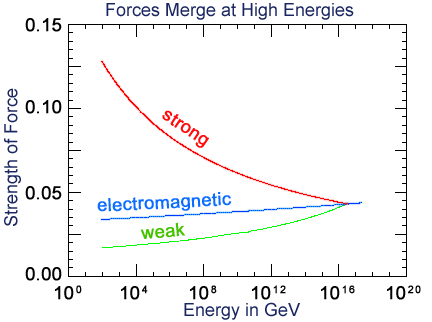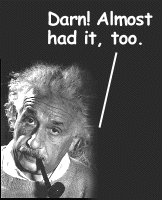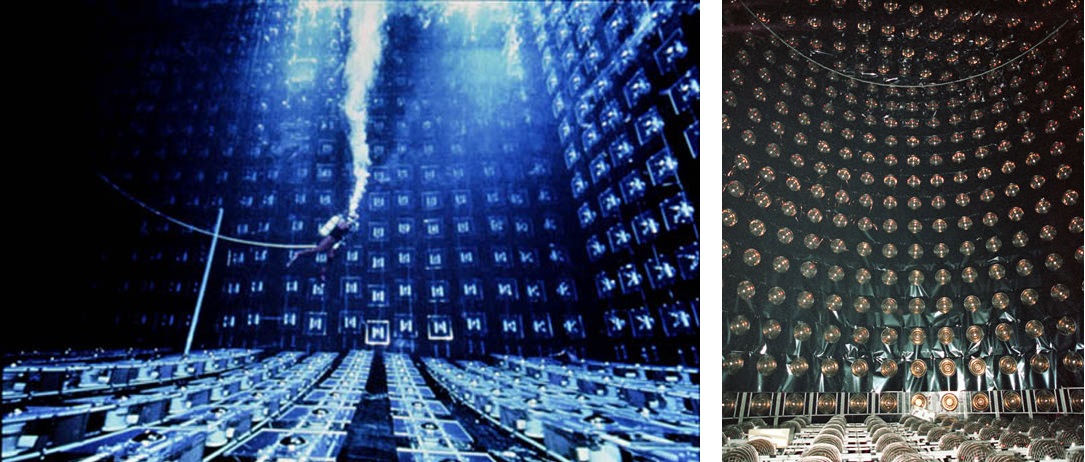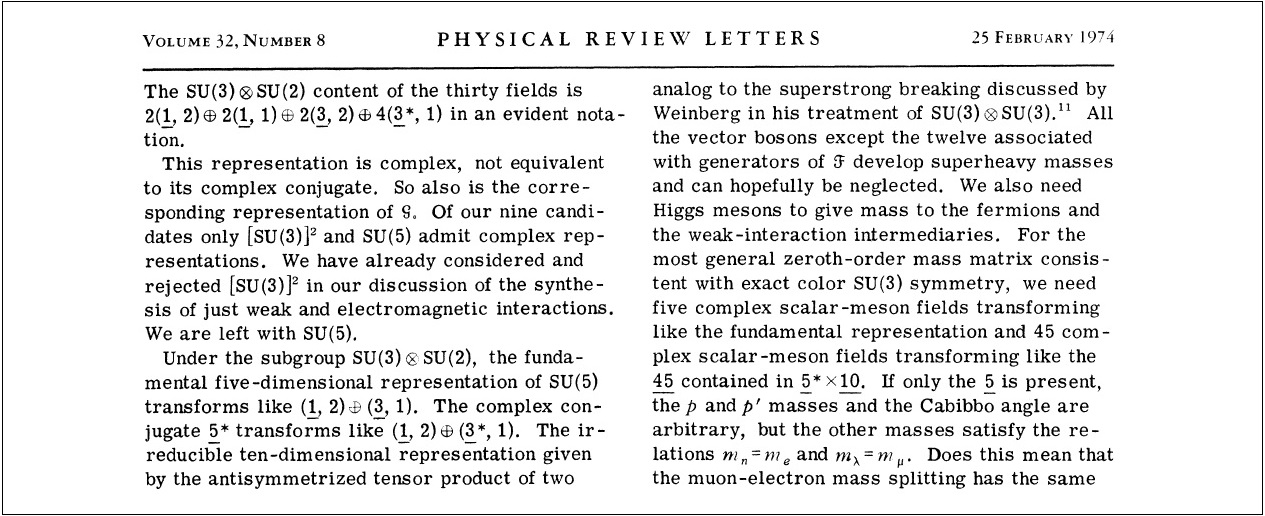I was talking to a guy the other day about Grand Unified Theories, and I thought I ought to say something about them. The Wikipedia Grand Unified Theory article gives a fair account. It says a GUT is a model where “at high energy, the three gauge interactions of the Standard Model that define the electromagnetic, weak, and strong interactions, or forces, are merged into a single force”. You’ve doubtless seen the picture:
 Image from the particle adventure
Image from the particle adventure
That’s from the particle adventure website. They say this: “one of the major goals of particle physics is to unify the various fundamental forces in a Grand Unified Theory which could offer a more elegant understanding of the organization of the universe”. There’s not much wrong with that. The article then talks about a simplification of the Standard Model, and says this: “James Maxwell took a big step toward this goal when he unified electricity and magnetism”. That’s right. Maxwell combined the electric field and the magnetic field to give us the “greater whole” called the electromagnetic field.
A theory which united gravity and electromagnetism
Check out On Physical Lines of Force and see where Maxwell said this: “a motion of translation along an axis cannot produce a rotation about that axis unless it meets with some special mechanism, like that of a screw”. Push a current up the wire and the motor turns. Turn a dynamo and you push the current up the wire. It’s rather like turning a screw, where rotational motion is converted into linear motion. Or if you pump your pump-action screwdriver, linear motion is converted into rotational motion. Anyway, the particle adventure article says “physicists now understand that at high energies the electromagnetic and weak forces are aspects of the same force”. The article also talks about Einstein, saying he attempted, but failed, to write a theory which united gravity and electromagnetism:
 Image from the particle adventure
Image from the particle adventure
People tend to forget that there’s a fair amount of electromagnetism in relativity. See for example what Hermann Minkowski said in Space and Time: “In the description of the field caused by the electron itself, then it will appear that the division of the field into electric and magnetic forces is a relative one with respect to the time-axis assumed; the two forces considered together can most vividly be described by a certain analogy to the force-screw in mechanics; the analogy is, however, imperfect”. There’s the screw again. Note that Minkowski talked about one field and two forces. The field is the electromagnetic field. The forces are the linear “electric” force and the rotational “magnetic” force. Electromagnetic field interactions result in linear and/or rotational force on an electron. If you only see linear motion you might call it an electric field. If you only see rotational motion you might call it a magnetic field. But the field is the electromagnetic field. It’s quite simple once you see it.
Another force-carrier particle that causes the proton to decay
The next page on the particle adventure website talks about forces and the Grand Unified Theory. It says this: “If a Grand Unification of all the interactions is possible, then all the interactions we observe are all different aspects of the same, unified interaction. However, how can this be the case if strong and weak and electromagnetic interactions are so different in strength and effect? Strangely enough, current data and theory suggests that these varied forces merge into one force when the particles being affected are at a high enough energy. Current work on GUT suggests the existence of another force-carrier particle that causes the proton to decay. Such decays are extremely rare; a proton’s lifetime is more than 1032 years”. I’d say this is a fair description of what GUTs are all about.
A Brief History of the Grand Unified Theory of Physics
Another fair description is in the 2017 Nautilus article A Brief History of the Grand Unified Theory of Physics by Lawrence Krauss. Krauss tells how in 1974 two different groups of physicists at Harvard noticed something interesting. Sheldon Glashow along with Howard Georgi “looked for patterns among the existing particles and forces and sought out new possibilities using the mathematics of group theory”. The story goes that the electromagnetic and weak forces are unified at a high energy scale, into a single “electroweak force”. The same mathematical symmetry applies, but it’s said to be “spontaneously broken” by the Higgs field. This is said to interact with the particles that convey the weak force, but not the particles that convey the electromagnetic force. Krauss tells us how Glashow and Georgi tried to extend this idea to include the strong force, and “discovered that all of the known particles and the three non-gravitational forces could naturally fit within a single fundamental symmetry structure”. They speculated that this symmetry could spontaneously break at some ultra high energy scale resulting in separate strong and electroweak forces. Krauss goes on to say that Steven Weinberg and Georgi along with Helen Quinn noticed that the strong interaction got weaker at smaller distance scales, whilst the electromagnetic and weak interactions got stronger. They wondered whether the strength of the three different interactions might become identical at some small-distance scale. This would mean particles would exist that produce transitions between quarks which would mean protons would decay. Krauss tells us that after the success of electroweak theory, “the smell of grand synthesis was in the air”.
No proton decays were observed
The proton-decay scenario was straightforward: get a big tank of pure pure water, and put it deep underground surrounded by sensitive phototubes. Then wait to see a burst of light when a proton decayed. Two experiments were built, the $100m (?) IMB detector in Ohio, and the $100m Kamiokande detector in Japan. The former was completed in 1982, the latter in 1983. However no proton decays were ever observed. As a result “the simplest elegant model proposed by Glashow and Georgi was soon ruled out”. However “other proposals were made for unified theories that might cause proton decay to be suppressed beyond the limits of the ongoing experiments”. The experiments had some success as neutrino detectors, but not as proton decay detectors.
 IMB image from John Vander Velde’s IMB pages, KamiokaNDE image from history of the neutrino by Michel Cribier & others
IMB image from John Vander Velde’s IMB pages, KamiokaNDE image from history of the neutrino by Michel Cribier & others
Krauss tells us how the physics landscape later shifted, and “more precise measurements of the interactions” demonstrated that “the strength of the three forces will not unify at a single scale”. This would “drive up the Grand Unification scale and thus suppress the rate of proton decay”. He also says theorists “were driven by new mathematical tools to explore a possible new type of symmetry in nature, which became known as supersymmetry”. That’s where for every known boson there must exist a new fermion, and for every known fermion there must exist a new boson.
This symmetry cannot be manifest in the world
Krauss then tells us that “since we haven’t seen these particles, this symmetry cannot be manifest in the world at the level we experience it, and it must be broken”. Krauss then effectively says the mass-energy of the new particles could be so high that they exceed the energy available in any accelerator constructed thus far. He also says this: “What could be so attractive about a symmetry that suddenly doubles all the particles in nature without any evidence of any of the new particles? In large part the seduction lay in the very fact of Grand Unification”. He then talks about a Grand Unified theory at a mass scale 13 orders of magnitude higher than the scale of electroweak symmetry breaking. Then he says “the big question is why and how such a huge difference in scales can exist for the fundamental laws of nature”. Things go downhill a little when Krauss talks about virtual particles “which appear and disappear on timescales so short that their existence can only be probed indirectly”. He says they include particles of arbitrarily large mass, such as the gauge particles of a presumed Grand Unified Theory. Things go even more downhill when he starts talking about two Higgs bosons, dark matter particles, and string theory. But it’s still a good potted history.
Lepton number as the fourth color
Obviously it doesn’t contain every last little thing. For example it doesn’t mention Abdus Salam and Jogesh Pati. However Paul Langacker’s Scholarpedia article on Grand Unification does. It dates from 2012 and talks about “a (still unobserved) spin-0 Higgs particle”. That’s unusual. I wonder if that’s got anything to do with something he said in his section on problems with the Standard Model: “the electroweak symmetry breaking mechanism has not yet been established”. That’s food for thought. Especially since Langacker refers to the various Grand Unification papers from 1974: Lepton number as the fourth color by Pati and Salam, Unity Of All Elementary Particle Forces by Georgi and Glashow, and Hierarchy of interactions in unified gauge theories by Georgi, Quinn, and Weinberg. In the first paper Pati and Salam talked about lilac leptons grouped with the three-color quarks into something that featured four colors. The money-shot prediction is on page 286: “This would lead to quarks disintegrating into leptons”. The second paper, by Georgi and Glashow, talked about electromagnetic gauge invariance and said “all other gauge fields develop masses through the Higgs mechanism”. They also said a true unification would explain what charge is and why it’s unit charge. I think it’s a pity they didn’t follow up on that instead of talking about 30 fields on their last page:
 Fair use excerpt from Unity Of All Elementary Particle Forces by Georgi and Glashow
Fair use excerpt from Unity Of All Elementary Particle Forces by Georgi and Glashow
The third paper, by Georgi, Quinn, and Weinberg, is more of the same. They said “some of the superheavy vector bosons mediate proton decay into lepton plus pions” and “observation of proton decay with a lifetime of this order of magnitude would be a startling confirmation of the ideas discussed here”. They too refer to the Higgs mechanism. They mention “superheavy” 21 times, but they only mention the electron once.
You’re already in the desert, and you’ve been there for 45 years
But I digress. I was talking about Krauss’s article giving A Brief History of the Grand Unified Theory of Physics. He finished up saying this: “Are great new experimental insights just around the corner that may validate, or invalidate, some of the grander speculations of theoretical physicists?”. No Lawrence, they aren’t. He also said this: “Or are we on the verge of a desert where nature will give us no hint of what direction to search in to probe deeper into the underlying nature of the cosmos?” No Lawrence, you’re already in the desert, and you’ve been there for 45 years. Because people like Weinberg dug you into a hole. Did you notice how they tried to have two bites of the cherry by predicting proton decay and superheavy particles? The observation of either would have been trumpeted as a grand vindication of the Grand Unified hypothesis. Then when proton decay was not observed, did you notice how “more precise measurements of the interactions” demonstrated that “the strength of the three forces will not unify at a single scale”. And that this would “drive up the Grand Unification scale and thus suppress the rate of proton decay”.
It fails miserably, then they shift the goalposts
How very convenient. Weinberg and co makes a prediction, it fails miserably, then they shift the goalposts. Like the way symmetry-breaking shifted the goalposts when symmetry doesn’t work. Employing symmetry on the ephemeral particles produced in a collider is like cataloguing the firework explosions on New Year’s Eve and expecting to learn about gunpowder. It’s useless. In fact it’s worse than useless, and it’s been that way since the 1964 “discovery” of the Omega baryon. It was touted as proof positive of the eightfold way and group theory. However the Omega baryon was supposed to contain three strange quarks, so it was in breach of the Pauli exclusion principle. So Oscar Greenberg came up with a “fix” which would eventually become color charge and eight gluon fields. Such proliferation reached its nadir with supersymmetry. Predicting bosonic partners for the fermions and vice versa is cargo-cult fantasy physics based on utter ignorance. How can anybody seriously propose a selectron when they don’t know what an electron is? Or if they don’t understand what a photon is? Or if they think pair production occurs because pair production occurs? They don’t know that there’s a photon-photon interaction that’s actually rather strong. They don’t even know what a proton is, or why it goes round and round in a uniform magnetic field. Or why in low-energy proton-antiproton annihilation we see gamma photons, not quarks and gluons. Or why photons move at c, or why we can diffract protons. How can they propose a Grand Unification if they don’t understand how the forces work? When they don’t even understand Maxwell’s unification and the screw nature of electromagnetism?
Predicting the existence of magnetic monopoles is a huge red flag
I mean that. See the Wikipedia article on Grand Unified Theory. It says this: “Some GUTs, such as the Pati-Salam model, predict the existence of magnetic monopoles”. Predicting the existence of magnetic monopoles is a huge red flag. James Clerk Maxwell unified electricity and magnetism. The electron doesn’t have an electric field, it has an electromagnetic field. Hence electric charge is a misnomer. So magnetic charge is a misconception, and a Grand Unified Theory that predicts the existence of magnetic monopoles is flatly contradicting Maxwell’s unification. It’s similar when Georgi and Glashow talked about 30 fields on their last page. Did it never occur to these guys that they should have been reducing the number of fields, not increasing it? Did any of them actually read the original QFT papers of the 1920s? Did nobody realise that the exchange-particle idea worked its way into QED from the mid 1930s? Even though Heisenberg used a neutron model that was later retracted? Why didn’t any of them look at how gravity works? Was it because they knew it doesn’t need messenger particles? Did none of them ever read Einstein’s history of field theory where he said a field is a state of space? Then ask themselves how space can have 30 different states all in the same place? Did anybody pay attention to electron capture, or the way the nuclear force matches the neutron charge distribution? Or think about the way the Wu experiment showed that Beta decay has a chirality just like electromagnetism? Did not one of them know that the electron goes round in circles in a uniform magnetic field because of Larmor precession? Did nobody know that the electron and the positron go round in circles because they’re “dynamical spinors”. Because spin is real. Not because photons are popping in and out of existence. Spontaneously. Like worms from mud.
Here we are 45 years later and there’s still no Grand Unification
No they didn’t. And here we are 45 years later and there’s still no Grand Unification. The Standard Model still can’t tell you how a magnet works. Instead it tells you all about the quarks and gluons you’ve never ever seen, and about electroweak theory. The theory that started with Weinberg’s 1967 model of leptons. Which wasn’t a model of leptons at all, and was wrong from the very first sentence: “Leptons interact only with photons”. This is the electroweak theory which features the Higgs mechanism, which flatly contradicts E=mc². It also contradicts the bleeding obvious. When you’ve read papers like quantization as a problem of proper values, part II, you know this. That’s where Erwin Schrödinger said “let us think of a wave group of the nature described above, which in some way gets into a small closed ‘path’, whose dimensions are of the order of the wave length”. The photon has momentum because a wave in an open path has a resistance to change-in-motion. The electron has mass because a wave in a closed path has a resistance to change-in-motion. It’s that simple. The inertia of a body depends upon its energy-content. Not on its interaction with a cosmic-treacle field that was dreamt up to make massless gauge bosons massive.
Grand Unified Horseshit
As for the “discovery” of the W and Z boson I recommend Carlo Rubbia and the discovery of the W and Z by Gary Taubes. As for the “discovery” of the fabulous Higgs boson, I recommend The Higgs Fake by Alexander Unzicker. When a church needs a miracle, a church gets a miracle. Then it can continue to build a foundation-free castle in the air, made up of layer upon layer of mathematical fantasy, all held up by hype and hot air. Lawrence Krauss’s article A Brief History of the Grand Unified Theory of Physics is based on his book The Greatest Story Ever Told… So Far. But it isn’t the greatest story ever told. It’s the greatest fairy story ever told. Because the Grand Unified Theories by Weinberg and co are Grand Unified Horseshit.
Hi John,
I continue to really like your blog and I believe that a GUT will never be found unless some of the foundational assumptions of existing theories are looked at and tossed out. I have recently come across the work of John Macken who is putting forth a theory that everything is made out of spacetime. A good primer can be found here: http://onlyspacetime.com/QM-Foundation.pdf as well as his book which I am just starting to get in to. I am finding many of the ideas that you have brought up to be present and taken into account in his work. I think its good stuff and am curious if you have seen it before.
Neil
Hi Neil, thanks. I know John Macken from a SPIE email group talking about the nature of the photon. I dropped out on 2nd March 2017 because it was like trying to talk in a noisy crowded room. Uh oh, he sent this paper to the group on 6th February 2017 and I don’t think I read it. I’ll read it.
.
I share your sentiment re a GUT, but I think there are foundations in the older papers which were tossed out by the Copenhagen school. I’m writing something about that for the next article.
I finally read it Neil. Sorry to be slow, I was busy writing my next article. Here’s what I think:
.
He said spacetime when he should have said space. A gravitational field is inhomogeneous space.
The electrostatic force isn’t the same thing as gravitational force.
But I think this is broadly correct: “The universe is only spacetime”. I’d prefer he talked of space and waves, but never mind.
I didn’t like “the 17 particles of the standard model would all be related because they would be different excitations of the single spacetime field”. The only stable particles are electrons, protons, photons, and neutrinos. Plus antiparticles.
I’m pretty sure this is wrong: “the locally violent conditions that characterize the vacuum”. See Svend Rugh and Henrik Zinkernagel’s 2002 paper on the quantum vacuum and the cosmological constant problem: http://philsci-archive.pitt.edu/398/. They say photons do not scatter on the vacuum fluctuations of QED. If they did, “astronomy based on the observation of electromagnetic light from distant astrophysical objects would be impossible”. They also say the QED vacuum energy concept “might be an artefact of the formalism with no physical existence independent of material systems”.
So it looks like there are issues with section 2. I dislike his “Planck amplitude waves”. I think he ought to be starting with the photon, and saying all photons have the same amplitude.
I think this is section 3 is largely correct: “The analogy to a vortex in a superfluid is that a fundamental fermion such as an electron is proposed to be a rapidly rotating Planck amplitude wave in spacetime with ћ/2 of quantized angular momentum”. Only I think the amplitude is the wavelength divided by 2π.
I think this is right “only specific combinations of wave amplitude and rotational frequency achieve stability”.
IMHO his section 5 ought to be talking about the photon then gamma-gamma-pair production then the electron. I’m confident that it’s a 511keV photon in a spin ½ double loop configuration, as per the Williamson / van der Mark paper.
In section 6 he says the: “Electric and magnetic fields are also proposed to be a distortion of the spacetime field”. It’s the electromagnetic field.
Overall I’d say he’s on the right lines, but has considerable work to do yet.
Neil: a guy called Alan Smith told me about this recently:
.
https://www.lenr-forum.com/attachment/10070-thomas-minderle-a-brief-introduction-to-scalar-physics-pdf/
.
It’s by Thomas Minderle. I read it, and thought it was promising. Sure, there’s some issues. Primarily I’d say that’s because he has no electron model. But I think he’s barking up the right tree.
Simon Brink at Subtle Atomics in Australia , Unified Field Theory , Dark Matter , The environmental engineer is on his way to LENR commercialization . http://www.subtleatomics.com
What’s that Wayne? Hmmn. I took a look at http://www.subtleatomics.com/electrons. I noted this: “In the new model a ‘primary electron’ is identified, defined as an electron with one wavelength per rotaton, so a single primary electron has a mean radius equivalent to the reduced crompton wavelength, i.e. ~386fm, see text box on the right”. It should be rotation instead of rotaton, There’s half a wavelength per rotation. And it’s the Compton wavelength, not the crompton wavelength. He ought to read this: https://physicsdetective.com/the-electron/. I sent him a contact-form message.